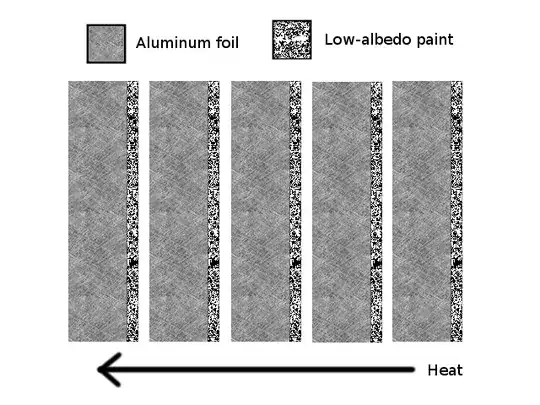If we assume that both the aluminum foil and the paint have scalar heat conductivities then their composite will also be scalar, and thus symmetrical. Being both material either poly-crystalline or amorphous this is probably reasonable assumption.
@Floris suggested that I expand on this, but not being my area I can only summarize a few ideas from Truesdell's Rational Thermodynamics, chapter 7.
It is an old problem going back to Stokes (1851) whether the heat conductivity tensor $\mathbf{K}$, that is the tensor in the linear Fourier law between temperature gradient and heat flux written as $ \vec q = \mathbf{K} \nabla T $ for crystalline materials is always symmetric or not. Assume the simplest case of $\mathbf{K}$ independent of the temperature and deformation, then one gets from the 1st law $\rho c \partial_t{T} = \mathbf{K_{+}} \nabla^2{T}$ and from the 2nd law that $\mathbf{K_+}$ is positive definite, where $\mathbf{K_{\pm}} = \frac {1}{2} (\mathbf {K}\pm \mathbf{K^T})$. Notice that in the 1st law only the symmetric part of the tensor shows up, hence the natural inclination to ignore the skew part.
Stokes proved that for heat conduction there are 13 types of crystals and for seven of those types $\mathbf{K_-} = 0$, $\mathbf{K}$ symmetrical. Out of the 32 optical crystal classes 19 are forced to have symmetric conductivity tensor. In only two triclinic classes the skew part $\mathbf{K_-}$ may seem to have any value, and in the other cases at least one component will always vanish. Stokes conjectured that $\mathbf{K}$ mus always be symmetrical but he could not prove so. In the ensuing decades may experiments were conducted to verify it either theoretically or experimentally (Voigt, Curie, Soret, etc.) Gurtin (1969) supposedly proved that a rigid heat conductor cannot be thermally stable unless its $\mathbf{K}$ is also symmetric but these are nontrivial results.
